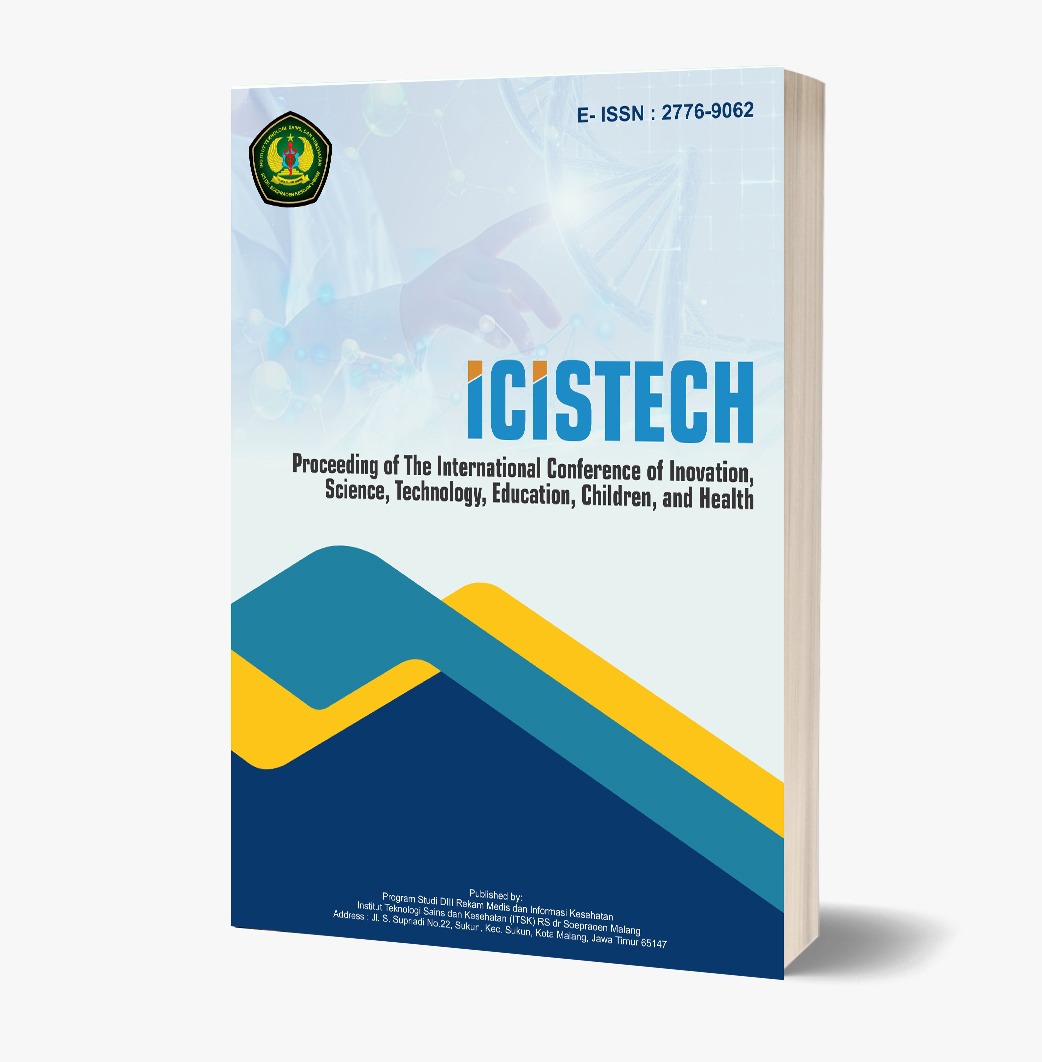Analysis of Factors Affecting Premature Labor in Pregnant Women Based on Various Health and Environmental Aspects
DOI:
https://doi.org/10.62951/icistech.v5i1.221Keywords:
Blood pressure, Infection, Parity, Pregnancy spacingAbstract
Preterm birth, defined as birth before 37 weeks of gestation, is a significant global health problem, with rising rates in many regions worldwide. The World Health Organization (WHO) reports that approximately 15 million babies are born prematurely every year, and this number continues to increase. Preterm birth is a major contributor to neonatal morbidity and mortality, making it an urgent issue for public health. This study aims to explore the various factors influencing the occurrence of preterm birth, including medical, social, and environmental factors. The study employed an observational analysis with a case-control design to identify and analyze these factors. Data were collected from medical records of deliveries that took place between January and December 2024. The study used a total sample size of 100 participants, consisting of 50 cases of preterm birth and 50 control cases. The control group was selected using simple random sampling to ensure unbiased selection. The data were analyzed using the chi-square test, and logistic regression was applied to assess the strength of the relationships between identified factors and the occurrence of preterm birth. The findings of this study indicate that several factors significantly contribute to the likelihood of preterm birth, including parity, pregnancy spacing, infections, and blood pressure (p-value < 0.05). These factors were found to increase the risk of preterm birth. The study concludes by emphasizing the need for early intervention to identify and manage these risk factors, thus minimizing the incidence of preterm birth. It is also recommended that pregnant women receive education and support programs aimed at reducing risk factors. Further research, especially longitudinal studies, is suggested to explore the mechanisms underlying preterm labor and to develop more effective preventive strategies.
References
Barber, K. S., Huber, L. R. B., Portwood, S. G., Boyd, A. S., Smith, J., & Walker, L. S. (2021). The association between having a preterm birth and later maternal mental health: An analysis of US pregnancy risk assessment monitoring system data. Women's Health Issues, 31(1), 49–56. https://doi.org/10.1016/j.whi.2020.08.007
Bertagnolli, M., Luu, T. M., Lewandowski, A. J., Leeson, P., & Nuyt, A. M. (2016). Preterm birth and hypertension: Is there a link? Current Hypertension Reports, 18, 1–8. https://doi.org/10.1007/s11906-016-0637-6
Boelig, R. C., Orzechowski, K. M., & Berghella, V. (2016). Cervical length, risk factors, and delivery outcomes among women with spontaneous preterm birth. The Journal of Maternal-Fetal & Neonatal Medicine, 29(17), 2840–2844. https://doi.org/10.3109/14767058.2015.1105957
Brhane, M., Hagos, B., Abrha, M. W., & Weldearegay, H. G. (2019). Does short inter-pregnancy interval predict the risk of preterm birth in Northern Ethiopia? BMC Research Notes, 12, 1–6. https://doi.org/10.1186/s13104-019-4439-1
Gagliardi, L., Rusconi, F., Bellù, R., Zanini, R., & Italian Neonatal Network. (2014). Association of maternal hypertension and chorioamnionitis with preterm outcomes. Pediatrics, 134(1), e154–e161. https://doi.org/10.1542/peds.2013-3898
Heikkilä, K., Pulakka, A., Metsälä, J., Alenius, S., Hovi, P., Gissler, M., ... & Kajantie, E. (2021). Preterm birth and the risk of chronic disease multimorbidity in adolescence and early adulthood: A population-based cohort study. PLOS One, 16(12), e0261952. https://doi.org/10.1371/journal.pone.0261952
Huang, H., Woodruff, T. J., Baer, R. J., Bangia, K., August, L. M., Jellife-Palowski, L. L., ... & Sirota, M. (2018). Investigation of association between environmental and socioeconomic factors and preterm birth in California. Environment International, 121, 1066–1078. https://doi.org/10.1016/j.envint.2018.07.027
Jamal, S., & Srivastava, R. (2017). A retrospective analytical study of the epidemiology and causes of preterm birth. Int J Reprod Contracept Obstet Gynecol, 6(12), 5453–5457. https://doi.org/10.18203/2320-1770.ijrcog20175259
Janša, V., Blickstein, I., Lučovnik, M., Fabjan-Vodušek, V., Verdenik, I., & Tul, N. (2018). The impact of inter-pregnancy interval on subsequent risk of preterm birth. The Journal of Maternal-Fetal & Neonatal Medicine, 31(5), 621–624. https://doi.org/10.1080/14767058.2017.1293027
Janssen, L. E., de Boer, M. A., von Königslöw, E. C., Oudijk, M. A., & de Groot, C. J. (2023). The association between spontaneous preterm birth and maternal hypertension in the fifth decade of life: A retrospective case-control study. BJOG: An International Journal of Obstetrics & Gynaecology, 130(5), 507–513. https://doi.org/10.1111/1471-0528.17368
Kashani-Ligumsky, L., Neiger, R., Segal, E., Cohen, R., & Lopian, M. (2024). Is parity a risk factor for late preterm birth? Results from a large cohort study. Journal of Clinical Medicine, 13(2), 429. https://doi.org/10.3390/jcm13020429
Koullali, B., Van Zijl, M. D., Kazemier, B. M., Oudijk, M. A., Mol, B. W., Pajkrt, E., & Ravelli, A. C. (2020). The association between parity and spontaneous preterm birth: A population-based study. BMC Pregnancy and Childbirth, 20, 1–8. https://doi.org/10.1186/s12884-020-02940-w
Liu, Y., Xu, J., Chen, D., Sun, P., & Ma, X. (2019). The association between air pollution and preterm birth and low birth weight in Guangdong, China. BMC Public Health, 19, 1–10. https://doi.org/10.1186/s12889-018-6307-7
Marinovich, M. L., Regan, A. K., Gissler, M., Magnus, M. C., Håberg, S. E., Mayo, J. A., ... & Pereira, G. (2021). Associations between interpregnancy interval and preterm birth by previous preterm birth status in four high‐income countries: A cohort study. BJOG: An International Journal of Obstetrics & Gynaecology, 128(7), 1134–1143. https://doi.org/10.1111/1471-0528.16606
Maulina, R., Qomaruddin, M. B., Sumarmi, S., Fahrul, A., & Haryuni, S. (2022). Antenatal depression as a stunting risk factor: A systematic review. Open Access Macedonian Journal of Medical Sciences, 10(F), 234–240. https://doi.org/10.3889/oamjms.2022.8501
Premkumar, A., Henry, D. E., Moghadassi, M., Nakagawa, S., & Norton, M. E. (2016). The interaction between maternal race/ethnicity and chronic hypertension on preterm birth. American Journal of Obstetrics and Gynecology, 215(6), 787-e1. https://doi.org/10.1016/j.ajog.2016.08.019
Shachar, B. Z., Mayo, J. A., Lyell, D. J., Baer, R. J., Jeliffe‐Pawlowski, L. L., Stevenson, D. K., & Shaw, G. M. (2016). Interpregnancy interval after live birth or pregnancy termination and estimated risk of preterm birth: A retrospective cohort study. BJOG: An International Journal of Obstetrics & Gynaecology, 123(12), 2009–2017. https://doi.org/10.1111/1471-0528.14165
Torchin, H., & Ancel, P. Y. (2016). Epidemiology and risk factors of preterm birth. Journal de Gynécologie, Obstétrique et Biologie de la Reproduction, 45(10), 1213–1230. https://doi.org/10.1016/j.jgyn.2016.09.013
Waldenström, U., Cnattingius, S., Vixner, L., & Norman, M. (2017). Advanced maternal age increases the risk of very preterm birth, irrespective of parity: A population‐based register study. BJOG: An International Journal of Obstetrics & Gynaecology, 124(8), 1235–1244. https://doi.org/10.1111/1471-0528.14368
Wang, E., Tang, P., & Chen, C. (2024). Urinary tract infections and risk of preterm birth: A systematic review and meta-analysis. Revista do Instituto de Medicina Tropical de São Paulo, 66, e54. https://doi.org/10.1590/s1678-9946202466054
Wheeler, S., Maxson, P., Truong, T., & Swamy, G. (2018). Psychosocial stress and preterm birth: The impact of parity and race. Maternal and Child Health Journal, 22, 1430–1435. https://doi.org/10.1007/s10995-018-2523-0
World Health Organization. (2023). Born too soon: Decade of action on preterm birth. World Health Organization.
Downloads
Published
How to Cite
Issue
Section
License
Copyright (c) 2025 Proceeding of The International Conference of Inovation, Science, Technology, Education, Children, and Health

This work is licensed under a Creative Commons Attribution-ShareAlike 4.0 International License.













